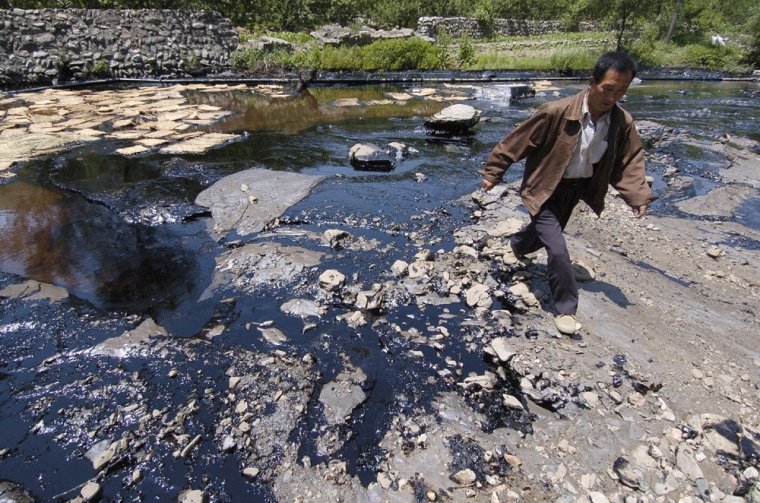The murky green Dasha River has been dirty for decades, polluted by coal mines and steel mills that make it fit only for watering livestock and crops downstream.
Then a truck overturned on a windy, mountain road this month, dumping at least 60 tons of potentially carcinogenic coal tar into the water. That spill killed off the Dasha’s remaining small fish, shrimp and frogs; stressed an already hard-pressed ecosystem; and incensed locals.
“No one died from the pollution, but our livelihoods are being threatened,” farmer Li Si said, standing above the river in Zhong’ershi village, three miles downriver from the accident.
“Once the river is flowing properly again, we’ll have to use this contaminated river to irrigate our crops.”
He kicked at the nearly dry river bed, exposing clumps of black, shiny coal tar embedded in the mud.
What happened along the Dasha illustrates China’s environmental predicament. An environment already out of balance from decades of overpopulation, intensive farming and rapid industrialization is being further degraded by accidents — often the result of lax regulation.
‘Initial success’
In the wake of the June 12 truck spill into the Dasha, officials mobilized a huge cleanup effort. This past week, they declared victory.
The government’s news agency, Xinhua, said Tuesday that the water quality had been restored to normal. The government in Fuping County, downriver from the accident, said the cleanup achieved “initial success.”
But a two-day trip to the mountainous area on the border of Shanxi and Hebei provinces, 190 miles from Beijing, tells a different story.
The air in riverside villages and towns reeked with the sour odor of coal tar. Along the banks, streaks of black, shiny sludge seeped through the sand. Weeds on the riverbed had withered, their leaves stained with black spots.
Many Chinese cities choke on filthy air, but dirty water is the nation’s most pressing environmental problem. Most of China’s canals, rivers and lakes are severely tainted by pollution, and only about a third of the 3.7 billion tons of wastewater discharged by China’s huge cities each year is treated.
Several serious accidents
Officials say there have been 76 polluting incidents in the past eight months.
In the worst, a factory explosion in November sent cancer-causing benzene into the Songhua River, which runs by tens of millions of people in northeast China and Russia. Authorities cut off running water to Harbin, a city of 3.8 million people, for five days.
The problem is compounded by the fact that many polluting industries have strong links to local governments, making officials reluctant to enforce environmental laws. Zhu Guangyao, deputy chief of the national environmental agency, said this month that local officials sometimes even work against Beijing-directed environmental protection efforts.
It was unclear when efforts to clean up the Dasha spill began, but the incident was not reported publicly until four days after it occurred. Leaders then faced immense pressure to stanch the spill before it reached the Wangkuai reservoir, which is used by Baoding, a city of 10 million people, and is a standby source for Beijing during the 2008 Olympics.
Coal tar is a byproduct in turning coal into coke for fuel. Prolonged exposure has been linked to increased rates of certain cancers, but it also is used in small doses as a topical medicine to treat eczema and other skin diseases, according to the World Health Organization’s International Agency for Research on Cancer.
Cleanup crews of firefighters, soldiers and locals built dozens of makeshift dams with sandbags. One of them was 1,210-foot-long dam. Xinhua said 4,470 tons of contaminated water had been removed since cleanup efforts started.
Cleanup, safety procedures lax
On Tuesday, crews were still at it, filling sandbags, trucking polluted water away and building pipes to bring clean upstream water to affected villages. But many farmers complained that the cleanup was not thorough, with workers covering up the coal tar with dirt instead of removing it.
In Dazhaikou village, a few hundred yards from where the truck overturned, streaks of sludge were visible on the concrete wall above the river.
Residents said workers piled mud on top of the sludge, which was now leaking through. One farmer, who refused to give his name to avoid angering local officials, said the cleanup was for show.
“Just smell the air and you know the problem is still around,” he said.
The makeshift dams reduced the Dasha to a shallow, yard-wide stream by the time it reached Zhong’ershi village, where 42-year-old Li Si lives.
Chinese state television said Friday the dams had been dismantled.
A fellow villager said Beijing likely demanded a good job but local leaders mishandled it.
“Our goats usually drink from this water; but how can we believe it is safe for them after only a week?” said the villager, who worked as a car repairman in a nearby town.
